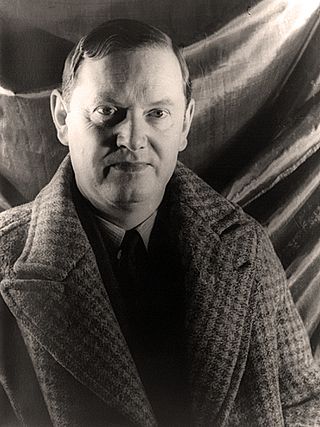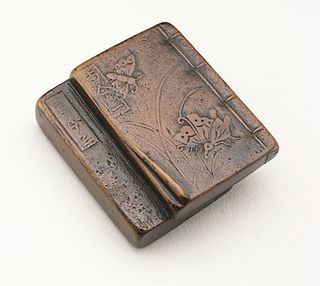A kenning is a figure of speech in the type of circumlocution, a compound that employs figurative language in place of a more concrete single-word noun. Kennings are strongly associated with Old Norse-Icelandic and Old English alliterative verse. They continued to be a feature of Icelandic poetry for centuries, together with the closely related heiti.

Old Norse, Old Nordic, or Old Scandinavian is a stage of development of North Germanic dialects before their final divergence into separate Nordic languages. Old Norse was spoken by inhabitants of Scandinavia and their overseas settlements and chronologically coincides with the Viking Age, the Christianization of Scandinavia and the consolidation of Scandinavian kingdoms from about the 8th to the 15th centuries.

The Poetic Edda is the modern name for an untitled collection of Old Norse anonymous narrative poems in alliterative verse. It is distinct from the closely related Prose Edda, although both works are seminal to the study of Old Norse poetry. Several versions of the Poetic Edda exist: especially notable is the medieval Icelandic manuscript Codex Regius, which contains 31 poems.

The Prose Edda, also known as the Younger Edda, Snorri's Edda or, historically, simply as Edda, is an Old Norse textbook written in Iceland during the early 13th century. The work is often considered to have been to some extent written, or at least compiled, by the Icelandic scholar, lawspeaker, and historian Snorri Sturluson c. 1220. It is considered the fullest and most detailed source for modern knowledge of Norse mythology, the body of myths of the North Germanic peoples, and draws from a wide variety of sources, including versions of poems that survive into today in a collection known as the Poetic Edda.

Thorn or þorn is a letter in the Old English, Old Norse, Old Swedish and modern Icelandic alphabets, as well as modern transliterations of the Gothic alphabet, Middle Scots, and some dialects of Middle English. It was also used in medieval Scandinavia, but it was later replaced with the digraph th, except in Iceland, where it survives. The letter originated from the rune ᚦ in the Elder Fuþark and was called thorn in the Anglo-Saxon and thorn or thurs in the Scandinavian rune poems. It is similar in appearance to the archaic Greek letter sho (ϸ), although the two are historically unrelated. The only language in which þ is currently in use is Icelandic.

The Norsemen were a North Germanic linguistic group of the Early Middle Ages, during which they spoke the Old Norse language. The language belongs to the North Germanic branch of the Indo-European languages and is the predecessor of the modern Germanic languages of Scandinavia. During the late eighth century, Scandinavians embarked on a large-scale expansion in all directions, giving rise to the Viking Age. In English-language scholarship since the 19th century, Norse seafaring traders, settlers and warriors have commonly been referred to as Vikings. Historians of Anglo-Saxon England distinguish between Norse Vikings (Norsemen) from Norway, who mainly invaded and occupied the islands north and north-west of Britain, as well as Ireland and western Britain, and Danish Vikings, who principally invaded and occupied eastern Britain.

In prosody, alliterative verse is a form of verse that uses alliteration as the principal device to indicate the underlying metrical structure, as opposed to other devices such as rhyme. The most commonly studied traditions of alliterative verse are those found in the oldest literature of the Germanic languages, where scholars use the term 'alliterative poetry' rather broadly to indicate a tradition which not only shares alliteration as its primary ornament but also certain metrical characteristics. The Old English epic Beowulf, as well as most other Old English poetry, the Old High German Muspilli, the Old Saxon Heliand, the Old Norse Poetic Edda, and many Middle English poems such as Piers Plowman, Sir Gawain and the Green Knight, Layamon's Brut and the Alliterative Morte Arthur all use alliterative verse.
The orthography of the Old Norse language was diverse, being written in both Runic and Latin alphabets, with many spelling conventions, variant letterforms, and unique letters and signs. In modern times, scholars established a standardized spelling for the language. When Old Norse names are used in texts in other languages, modifications to this spelling are often made. In particular, the names of Old Norse mythological figures often have several different spellings.

Icelandic names are names used by people from Iceland. Icelandic surnames are different from most other naming systems in the modern Western world in that they are patronymic or occasionally matronymic: they indicate the father of the child and not the historic family lineage. Iceland shares a common cultural heritage with the Scandinavian countries of Denmark, Norway, and Sweden. Unlike these countries, Icelanders have continued to use their traditional name system, which was formerly used in most of Northern Europe. The Icelandic system is thus not based on family names. Generally, with few exceptions, a person's last name indicates the first name of their father (patronymic) or in some cases mother (matronymic) in the genitive, followed by -son ("son") or -dóttir ("daughter").

A unisex name is a given name that is not gender-specific. Unisex names are common in the English-speaking world, especially in the United States. By contrast, some countries have laws preventing unisex names, requiring parents to give their children sex-specific names. In other countries or cultures, social norms oppose such names and transgressions may result in discrimination, ridicule, and psychological abuse.

Japanese poetry is poetry typical of Japan, or written, spoken, or chanted in the Japanese language, which includes Old Japanese, Early Middle Japanese, Late Middle Japanese, and Modern Japanese, as well as poetry in Japan which was written in the Chinese language or ryūka from the Okinawa Islands: it is possible to make a more accurate distinction between Japanese poetry written in Japan or by Japanese people in other languages versus that written in the Japanese language by speaking of Japanese-language poetry. Much of the literary record of Japanese poetry begins when Japanese poets encountered Chinese poetry during the Tang dynasty. Under the influence of the Chinese poets of this era Japanese began to compose poetry in Chinese kanshi); and, as part of this tradition, poetry in Japan tended to be intimately associated with pictorial painting, partly because of the influence of Chinese arts, and the tradition of the use of ink and brush for both writing and drawing. It took several hundred years to digest the foreign impact and make it an integral part of Japanese culture and to merge this kanshi poetry into a Japanese language literary tradition, and then later to develop the diversity of unique poetic forms of native poetry, such as waka, haikai, and other more Japanese poetic specialties. For example, in the Tale of Genji both kanshi and waka are frequently mentioned. The history of Japanese poetry goes from an early semi-historical/mythological phase, through the early Old Japanese literature inclusions, just before the Nara period, the Nara period itself, the Heian period, the Kamakura period, and so on, up through the poetically important Edo period and modern times; however, the history of poetry often is different from socio-political history.
A heiti is a synonym used in Old Norse poetry in place of the normal word for something. For instance, Old Norse poets might use jór "steed" instead of the prosaic hestr "horse".

Kemp Malone was an American medievalist, etymologist, philologist, and specialist in Chaucer who was lecturer and then professor of English Literature at Johns Hopkins University from 1924 to 1956.
Johannes is a Medieval Latin form of the personal name that usually appears as "John" in English language contexts. It is a variant of the Greek and Classical Latin variants, itself derived from the Hebrew name Yehochanan, meaning "Yahweh is gracious". The name became popular in Northern Europe, especially in Germany because of Christianity. Common German variants for Johannes are Johann, Hannes, Hans, Jens and Jan. In the Netherlands, Johannes was without interruption the most common masculine birth name until 1989. The English equivalent for Johannes is John.

Faroese literature, in the traditional sense of the word, has only really developed in the past two hundred years. This is mainly because of the islands' isolation, and also because the Faroese language was not written down in a standardised format until 1890. Until then the Danish language was encouraged at the expense of Faroese. Nevertheless, the Faroese language soon became a vehicle for literature in its own right and has produced writers in several genres.
Icelandic literature refers to literature written in Iceland or by Icelandic people. It is best known for the sagas written in medieval times, starting in the 13th century. As Icelandic and Old Norse are almost the same, and because Icelandic works constitute most of Old Norse literature, Old Norse literature is often wrongly considered a subset of Icelandic literature. However, works by Norwegians are present in the standard reader Sýnisbók íslenzkra bókmennta til miðrar átjándu aldar, compiled by Sigurður Nordal on the grounds that the language was the same.

The history of the Icelandic language began in the 9th century when the settlement of Iceland, mostly by Norwegians, brought a dialect of Old Norse to the island.

Icelandic is a North Germanic language spoken by about 314,000 people, the vast majority of whom live in Iceland, where it is the national language. Since it is a West Scandinavian language, it is most closely related to Faroese, western Norwegian dialects, and the extinct language Norn. It is not mutually intelligible with the continental Scandinavian languages and is more distinct from the most widely spoken Germanic languages, English and German. The written forms of Icelandic and Faroese are very similar, but their spoken forms are not mutually intelligible.
Jóhann is a masculine given name. It is the Icelandic and Faroese form of the name Johann, a form of the Germanic and Latin given name "Johannes". The English-language form is John.











